The Elephanta Caves are cave temples dedicated to Mahadev. Essentially, they are a site of Hindu worship. Does anybody worship Mahadev inside these marvellous temples anymore? No. These temples have become mere tourist spots, where adharmic activities of the highest order can take place, where adharmics can do just about anything, and where nobody is required to take their shoes off even while standing close to the Shiva Lingams.
All of this, while authorities taking care of the site will not blink an eye. They have a rather high tolerance capacity for nuisance and are more concerned about minting as much money as possible from tourists.
The Elephanta Caves contain rock cut stone sculptures, mostly in high relief, that show syncretism of Hindu and Buddhist ideas and iconography. Except for a few exceptions, much of the artwork is defaced and damaged. The main temple’s orientation as well as the relative location of other temples are placed in a mandala pattern. The Elephanta Caves are most commonly placed between the 5th and 7th centuries.
Did you know that the temples inside these caves were sites of active worship until Portuguese colonisers set foot in India with an extremist form of Christianity in their hands?
They established a base on Elephanta island. The name ‘Elephanta caves’ is also a legacy that Indians have carried over for incomprehensible and uncreative reasons. The island is called ‘Gharapuri’, and there is an immediate need to refer to the caves as such. The term ‘Gharapuri Leni’ is used by locals, and that is what should be mainstreamed soon.
How the UNESCO Tag has Made Things Worse
What does a UNESCO World Heritage Site designation mean? It means that a monument or a city is a protected site, due to its importance based on any one of ten selection criteria including historical, cultural or architectural significance.
The management body of the heritage site also gets generous funding from UNESCO, which is the biggest socio-cultural preservation institution in the world.
The thing with the UNESCO World Heritage designation is that it is centred totally on tourism. What the designation does is protect the cultural, archaeological and architectural importance of the location, while also boosting tourism.
One of the unintended consequences of UNESCO protection is extreme tourist development. And when a temple is reduced into a picnic stop, you have people doing what they like — norms get blurred and people can come in wearing jeans, pyjamas, shorts and other such attire. You are not left with a dress code. And while some devotees will wear traditional attire out of respect, not everyone will be courteous enough.
Brihadisvara Temple, a Hindu mandir dedicated to Mahadev Shiva located in Tamil Nadu’s Thanjavur on the southern bank of the Cauvery River too is a UNESCO World Heritage Site. Today, it has become a tourist hotspot.
Read more: How UNESCO’s world heritage status hurts the sanctity of Thanjavur’s Brihadisvara Temple
Similarly, the Gharapuri Leni (Elephanta caves) are also a UNESCO World Heritage Site. Anyone visiting Mumbai makes it a point to visit these caves. Not for spiritual, religious or cultural purposes, mind you. But simply for recreation and photography. These magnificent cave temples of Mahadev have been turned into tourist spots with unrestricted entry, and a spot where indecency has become an acceptable form of behaviour.
https://twitter.com/PranitSatardek1/status/1475350359493136385?s=20
With people in the country becoming financially capable to boost tourism, tourists are increasingly looking for ‘new’ sites to visit. Tourists often end up searching for amazing destinations and what better destination to visit than a UNESCO World Heritage Site?
Unfortunately, nobody is aware of the sacred nature of the Gharapuri caves. The stone carvings of Hindu deities too, do not seem to affect tourists, who walk around the caves with absolute contempt for tradition.
There is an immediate need for Indians to read up the history of these pious caves and develop a sense of reverence which is fast becoming absent among them.
Also Read: Tiruvannamalai Arunachaleshwar Temple – History & how to reach
